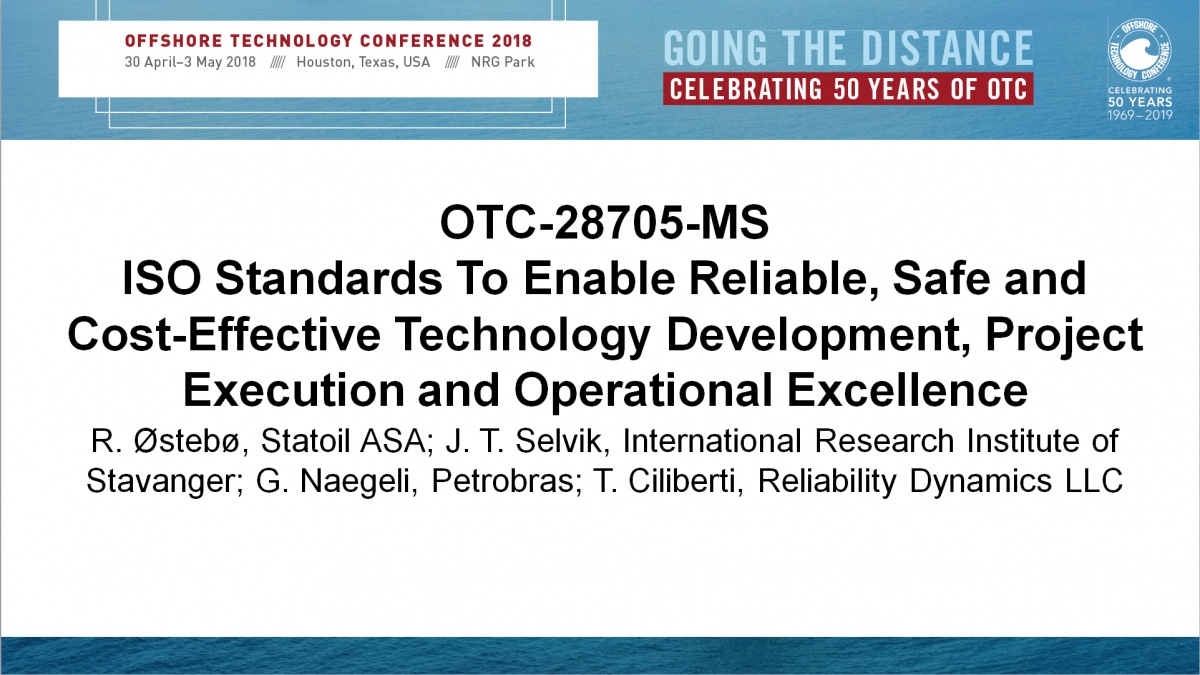
Technical Library
- Corporate Equipment Reliability InsightsFive-minute readFebruary 2020Please log-in/register to access this resource
- Practical application of ISO 14224 methods in corporate software4th ISO seminar on international standardization in the reliability technology and cost area, Statoil, Houston, USAMay 2018Please log-in/register to access this resource

- ISO Standards To Enable Reliable, Safe and Cost-Effective Technology Development, Project Execution and Operational ExcellenceR. Østebø, Statoil ASA; J. T. Selvik, International Research Institute of Stavanger; G. Naegeli, Petrobras; T. Ciliberti, Reliability Dynamics LLCMay 2018Please log-in/register to access this resource

This paper addresses the current oil & gas industry need for awareness and how to accelerate use of international standardization efforts, with focus on multi-disciplinary ISO standards and business governance. Qualified compliant use of ISO standards can unlock necessary business value and is a means to achieve cost-efficiency, HSE objectives, and minimize climate impact. The user domain encompasses regulatory bodies, oil and gas companies, drilling companies, engineering companies, equipment manufacturers, research & consultancies.
The ISO/TC67 Working Group “Reliability engineering and technology" has responsibility for reliability and cost related ISO standards within the Petroleum, petrochemical and natural gas industries. The portfolio of the multi-disciplinary ISO standards is internationally acknowledged and has recently been updated by many new standards that the global user domain can benefit from to achieve cost-reducing technologies. Reliability and cost is part of the equation in innovative technology development processes to enforce quality and minimize risk, and enable new technology meets overall business performance objectives.
This paper gives highlights of the following ISO standards and a roadmap for their application:
- ISO 14224 - Collection and exchange of reliability and maintenance data for equipment
- ISO 20815 - Production assurance and reliability management
- ISO 19008 - Standard cost coding system to gas production and processing facilities
Company applications are presented to show examples in technology development, project development, and oil & gas field operations. Standards relation to digitalization of oil and gas industry will also be addressed, eg. how “reliability communication” between oil company and supplier can benefit from use of the latest ISO standard 14224. Contractual framing of reliability and Key Performance Indicators is also be presented.
This ISO standardization work is based on international expert team efforts by many countries, and in collaboration with IOGP. The work supports the ISO/TC67 Mission: “To create value-added standards for the oil and gas industry," and the ISO/TC67 Vision: “International standards used locally worldwide.”
- ISPM Risk and Criticality AssessmentMay 2012Please log-in/register to access this resource
This document demonstrates the use of SAP Notification type R1 and ISO 14224 failure coding for capturing risk scenarios for process equipment. Since risk scenarios are simply hypothetical failures, the same failure coding used to document actual failures can and should be used. Thereby, failure scenarios can be validated by operational experience.
- Risk Management with Process Hazards Analysis (PHA)OSHA training courseMay 2011Please log-in/register to access this resource
Facilities risk management is a process of identifying risk through risk assessment, risk ranking, and applying safeguards to mitigate risk. A certain amount of risk reduction “credit” is taken for each safeguard applied. Follow-up “safeguard validation” is needed to ensure assumed risk credit is actually realized. Recording risk scenarios as structured relational data greatly simplifies safeguard validation and enables automated reporting processes (exception checking) to be used.




